| Author |
Message |
Frances Perry
Industry Professional

|
 Posted: Wed 10 Mar, 2010 10:00 am Post subject: Posted: Wed 10 Mar, 2010 10:00 am Post subject: |
 |
|
I found this pamphlet quite informative:
The Halberd and Other European Polearms 1300-1650 by George Snook, MD.(1998)
Snook indicates that the term halberd is can cover a variety of different shaped shafted weapons of a similar nature. The first mention of a halberd is found in a poem about the Trojan War by Konrad of Wurzburg written some time before 1287. It mentions 6,000 men carrying halberds.
The general characteristics are described below:
| Quote: | | The Halberd is an axe blade surmounted by a thrusting point backed by a pointed beak. this three part head is secured to a six to eight foot long shaft by a number of nails generally inserted through long straps known as langets. The langets extend along the shaft from the head towards the butt. The nials may be fastened from one side straight through the shaft to appear in a hole in the opposite langet.... . The head weighs about four pounds depending on the size of the blade. |
Snook goes on to differentiate the types of polearms, thrusting weapons such as spears and pikes, Cutting polearms such as the glaive and bardiche, purcussions polearms such as the spiked club, flail and horseman's hammer, and combination polearms such as the english bill - the pole axe is classified within this group.
Snook described the poleaxe as a variant of the halberd which was popular with the knightly class for use in foot combat and tournament:
| Quote: | | Its major use was "a outrance" (serious combat) using sharpened weapons rather than "a plaisance" (friendly combat) in which blunted weapons were used and little harm done to an opponent and was probably the answer to sturdier armour. It had a spear point and an axe blade but the beak was replaced by a hammer with rudimantary knobs to serve as a crushing tool. They were frequently ornamented with brass inlays and they are heavier than the halberd with a shorter shaft, and might have a rondel for a hand guard. It appears in the first half of the 15th century and disappears shortly after thereafter. |
[/quote]
“In these modern times, many men are wounded for not having weapons or knowledge of their use.”
- Achille Marozzo, 1536
|
|
   |
 |
|
Hugh Knight
|
 Posted: Wed 10 Mar, 2010 10:25 am Post subject: Posted: Wed 10 Mar, 2010 10:25 am Post subject: |
 |
|
| Frances Perry wrote: | Snook described the poleaxe as a variant of the halberd which was popular with the knightly class for use in foot combat and tournament:
| Quote: | | Its major use was "a outrance" (serious combat) using sharpened weapons rather than "a plaisance" (friendly combat) in which blunted weapons were used and little harm done to an opponent and was probably the answer to sturdier armour. It had a spear point and an axe blade but the beak was replaced by a hammer with rudimantary knobs to serve as a crushing tool. They were frequently ornamented with brass inlays and they are heavier than the halberd with a shorter shaft, and might have a rondel for a hand guard. It appears in the first half of the 15th century and disappears shortly after thereafter. |
|
In reality, very few deeds of arms (a "tournament" is a mounted melee) used blunted and rebated weapons in foot combat. Instead, weapons of war were used to attack less vulnerable targets. Consider the spear: Rather than thrusting toward gaps in the harness, they would be thrust into the breastplate and used to push backward, with the weaker man being shoved over (and if the point slipped, severe damage could occur; see the Deed of Arms at Vannes from Froissart's chronicles). The mistaken notion about blunted weapons comes from mounted combats in which lances were sometimes mounted with coronels for safety in jousts of peace, and from sources such as King Rene's Book of the Tournament which described a mounted melee fought with blunted and rebated swords or clubs.
While the mail, or hammer head, on pollaxes did enable them to be used for friendly Arms without necessarily causing killing damage, the spikes on the axe were often very sharp in these fights and serious wounds did occur. Pollaxes of the sort described above are seen in both friendly Arms and in war, suggesting they weren't specifically intended as weapons of peace. My research suggests strongly that the mail was added to the pollaxe simply because it was more effective against armored opponents, not because it was safer than the taillent or blade.
Scholars have re-examined the entire notion of "plaisance" and "outrance" combat since the poll arm article you cite was written (see Deeds of Arms by Steve Muhlberger, and there should be a new paper out on this shortly from Will McLean).
Regards,
Hugh
www.schlachtschule.org
|
|
    |
 |
Gerald Fa.

|
 Posted: Wed 10 Mar, 2010 11:02 am Post subject: Posted: Wed 10 Mar, 2010 11:02 am Post subject: |
 |
|
| Michael G. wrote: | | Hugh Knight wrote: |
Modern people might be confused about that weapon, Michael, but Fechtbuch sources agree with you--both Mair and Falkner call that weapon a halberd, specifically, not a pollaxe: Hellebarde, not Streitaxt (or just "axt"). To be a pollaxe it has to have a hammer head. |
I'm glad I'm not the only one that would call that one a halberd! On the other hand, I'm not sure I entirely agree that a poleaxe has to have a hammer head. Would you call this weapon a halberd, poleaxe, or something else?

I would call it a poleaxe, based on its style and construction. The way the head is attached to the haft, the specific shape of the axe and fluke, and the rondel are all things I associate with the poleaxe, not the halberd. The St. Louis Art Museum, where it resides, calls it a pollaxe. |
Looks more like of an personal weapon so in tern it looks like a poleaxe. Like I said, both can have hammers on back, or small axes. But the Halberd is to be longer, the Poleaxe is going to be shorter and more often with a bit of grip support like a personal weapon rather then for formation fighting...
|
|
  |
 |
Bill Grandy
myArmoury Team


|
 Posted: Wed 10 Mar, 2010 11:12 am Post subject: Posted: Wed 10 Mar, 2010 11:12 am Post subject: |
 |
|
| Gerald Fa. wrote: | | But the Halberd is to be longer, the Poleaxe is going to be shorter and more often with a bit of grip support like a personal weapon rather then for formation fighting... |
But, as has already been pointed out in this thread, that is a modern definition, not a historical one. The illustrated weapons that Paulus Kal called a poleaxe are bigger than the weapons that Joachim Meyer called a Halberd. And Meyer was showing their use one on one, not in formation (which is not to say one couldn't apply those techniques to a formation setting).
HistoricalHandcrafts.com
-Inspired by History, Crafted by Hand
"For practice is better than artfulness. Your exercise can do well without artfulness, but artfulness is not much good without the exercise.” -anonymous 15th century fencing master, MS 3227a
|
|
   |
 |
|
Hugh Knight
|
 Posted: Wed 10 Mar, 2010 11:17 am Post subject: Posted: Wed 10 Mar, 2010 11:17 am Post subject: |
 |
|
| Gerald Fa. wrote: | | Looks more like of an personal weapon so in tern it looks like a poleaxe. Like I said, both can have hammers on back, or small axes. But the Halberd is to be longer, the Poleaxe is going to be shorter and more often with a bit of grip support like a personal weapon rather then for formation fighting... |
I'm not exactly sure what you mean by a "personal weapon" or how that relates to the differences between pollaxes and halberds. To me, it looks like a ceremonial weapon, and, as such, might be very highly decorated without belonging to any specific individual (well, other than the lord who issued it) for use by guards. Many "common" weapons usually associated with lower-class soldiers were made in highly-decorated versions for this kind of ceremonial purpose; that doesn't change their weapon type.
And while some halberds do tend to be a bit longer than some pollaxes, that's not a good distinction (although it does *tend* to be true) from the point of view of finding a precise definition. For example, in Renaissance Martial Arts, Sydney Anglo says that Pietro Monte says this of pollaxe length:
"[B]ut Monte, in 1509, declares that the axe, up to its hammer head, should be ‘one hand’ longer than the man using it. If to this we add the length of the dague… then something well over six feet would have been in order." (p. 154).
I think we've already hit upon a more useful definition of the differences between pollaxes and halberds: Pollaxes have hammer heads, halberds do not. This distinction matches what we see in the Fechtbücher.
Regards,
Hugh
www.schlachtschule.org
|
|
    |
 |
Jean Thibodeau

|
 Posted: Wed 10 Mar, 2010 11:56 am Post subject: Posted: Wed 10 Mar, 2010 11:56 am Post subject: |
 |
|
| Hugh Knight wrote: |
I think we've already hit upon a more useful definition of the differences between pollaxes and halberds: Pollaxes have hammer heads, halberds do not. This distinction matches what we see in the Fechtbücher. |
I think that having a hammer makes the weapon, whatever we call it, distinct in use, in what it can do in comparison to a weapon with an axe head and a back hook known as a halberd.
If we define halberd as having an axe blade, a top spike or blade + a back hook in the later versions ( early ones often didn't have a back hook ).
With the Pollaxe we have many variants.
A) Small axe head, top spike, hammer head.
B) Bec de Corbin, top spike, hammer head ( regular hammer or one of those pronged Lucerne hammer )
C) Hard to classify variants, that like the one shown in the pics in the above posts, seems functionally to be a halberd but in aesthetic styling really does at a glance resemble a pollaxe.
Many pollaxes also have a queue with a spike at the other end, something that one doesn't see with a halberd. ( There might be some but I haven't seen or heard of any halberds with a butt spike ).
Oh, I don't mean my A, B, C classification to be complete or exhaustive and is just my personal way of deciding for myself what I perceive as a halberd or a pollaxe when I see one ...... whichever one .....  
You can easily give up your freedom. You have to fight hard to get it back!
|
|
  |
 |
Gerald Fa.

|
 Posted: Wed 10 Mar, 2010 12:25 pm Post subject: Posted: Wed 10 Mar, 2010 12:25 pm Post subject: |
 |
|
| Bill Grandy wrote: | | Gerald Fa. wrote: | | But the Halberd is to be longer, the Poleaxe is going to be shorter and more often with a bit of grip support like a personal weapon rather then for formation fighting... |
But, as has already been pointed out in this thread, that is a modern definition, not a historical one. The illustrated weapons that Paulus Kal called a poleaxe are bigger than the weapons that Joachim Meyer called a Halberd. And Meyer was showing their use one on one, not in formation (which is not to say one couldn't apply those techniques to a formation setting). |
Well, I did not say you cannot use a halberd it for one on one. I said it was more for, meaning it was better for.
| Hugh Knight wrote: |
I think we've already hit upon a more useful definition of the differences between pollaxes and halberds: Pollaxes have hammer heads, halberds do not. This distinction matches what we see in the Fechtbücher. |
Well, it may look like I may have to read a lot more about pole arms then I thought... But this is what I understood and seen in A.R.M.A.
| Hugh Knight wrote: | | Gerald Fa. wrote: | | Looks more like of an personal weapon so in tern it looks like a poleaxe. Like I said, both can have hammers on back, or small axes. But the Halberd is to be longer, the Poleaxe is going to be shorter and more often with a bit of grip support like a personal weapon rather then for formation fighting... |
I'm not exactly sure what you mean by a "personal weapon" or how that relates to the differences between pollaxes and halberds. To me, it looks like a ceremonial weapon, and, as such, might be very highly decorated without belonging to any specific individual (well, other than the lord who issued it) for use by guards. Many "common" weapons usually associated with lower-class soldiers were made in highly-decorated versions for this kind of ceremonial purpose; that doesn't change their weapon type.
And while some halberds do tend to be a bit longer than some pollaxes, that's not a good distinction (although it does *tend* to be true) from the point of view of finding a precise definition. For example, in Renaissance Martial Arts, Sydney Anglo says that Pietro Monte says this of pollaxe length:
"[B]ut Monte, in 1509, declares that the axe, up to its hammer head, should be ‘one hand’ longer than the man using it. If to this we add the length of the dague… then something well over six feet would have been in order." (p. 154). |
This is what I classify them by my understanding, but I can be wrong…
Pole-axe:
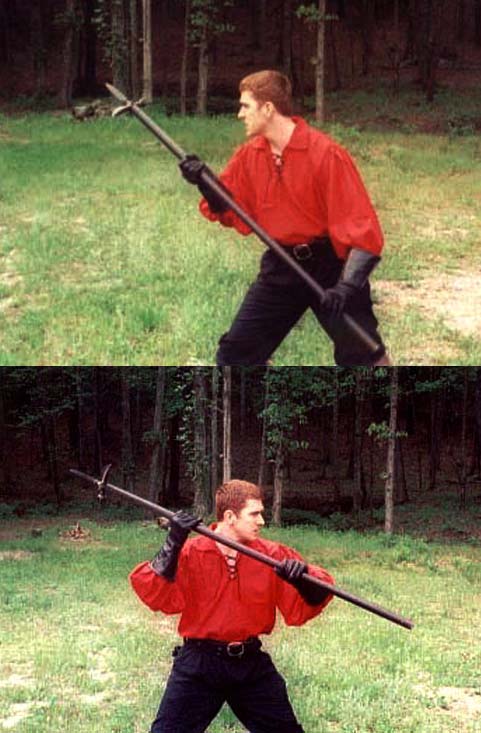


Halberds:
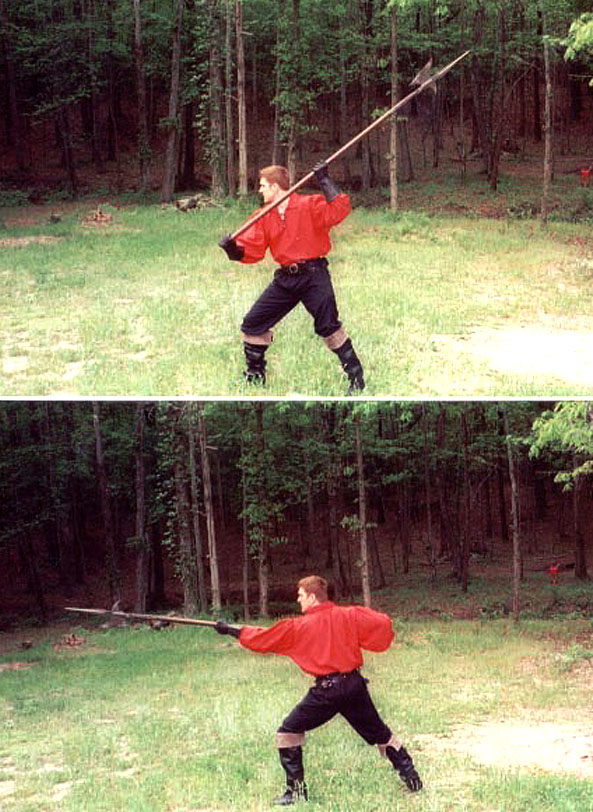

http://bp0.blogger.com/_tabXNZ-AHAw/SIBrO98r9...010459.jpg
As you can see, there will be a guy in there with a short pole-axe... (I do not think all of these are halberds)
But I can be wrong, and I guess I will have to read up on my pole arms... This is just how I see them to be.
|
|
  |
 |
|
Christian Borglum
Location: California Joined: 21 Feb 2010
Posts: 37
|
 Posted: Wed 10 Mar, 2010 3:32 pm Post subject: Halberd vs Polaxe en masse? Posted: Wed 10 Mar, 2010 3:32 pm Post subject: Halberd vs Polaxe en masse? |
 |
|
Hello Everyone,
This thread discussion is quite interesting and seems emblematic of the scholastic problems we have dealing with polearms. As so many of these weapons share common cunstruction elements across examples catagorization gets difficult. We have surviving texts from masters like Meyer and Paulus Kal that deal in the individual usseage of the Hellebarde and Streitaxt, and it seems the conceses of our modern WMA scholars is that the techniques for these weapons as wielded in that context, are more similar than different.
What if we think about how the Halberd or the Polaxe would be used in mass, by a body of men fighting in formation. Would the minor differences in shaft length or between the heads, allow for, or possibly dictate different fighting techniques in that context?
The butt spike sometimes found on Polaxes or polhammers would seem to be of little value in a tightly packed or crowded formation. If there are any notable differences in unit usage betwean the Halberd and the Polaxe, maybe we can then apply those thoughts to identifying surviving examples which are harder classify, just an idea...
Cheers,
Christian Borglum
|
|
   |
 |
|
Nicholas A. Gaese
Location: Montreal, Quebec, Canada Joined: 06 Aug 2007
Posts: 100
|
 Posted: Thu 11 Mar, 2010 1:01 pm Post subject: Posted: Thu 11 Mar, 2010 1:01 pm Post subject: |
 |
|
Good day everyone!
Very informative discussion. To me Pollaxes and halberds often have a distinct form and style that which often dictates it's usage and in turn who used it. Pollaxes were associated with knights so they generally were better at dealing with armor. Halberds faced a much wider range of opponents but lets also not leave out the possibility of ease of production. Pollaxes often were of fine make, commissioned by individual knights to a form that matched the knights personal preferences. Many Halberds were of fine quality too, but equally so there are many utilitarian designs made for masses of infantry. Off course though, these lines can blend a bit and many variations occur like the examples shown before, but generally many of us have seen enough examples of both to tell the difference our selves. They just have different characters we can all identify.
As for something else that might be more useful to some in this thread, I remember the mentioning of halberd-like pollaxes with wedge shaped back spikes. This is interesting and I happen to have one image that displays this.
best regards
Nick
 Attachment: 92.62 KB Attachment: 92.62 KB
From Maxilimions Triumpfzug, edited to fit. [ Download ]
|
|
  |
 |
Sean Flynt

|
 Posted: Thu 11 Mar, 2010 1:48 pm Post subject: Posted: Thu 11 Mar, 2010 1:48 pm Post subject: |
 |
|
It seems to me, too, that the poleaxe is optimized for use against armoured targets while the halberd is more of a multipurpose weapon. It doesn't necessarily cut as well as a sword, thrust as well as a spear or chop as effectively as an axe, but it combines elements of those weapons in a single, lightweight arm well suited to the typical combat mission of the day.
To elaborate on earlier comments--I, too, have been under the impression that although the halberd can be used in individual combat (there are illustrations of individual "fencing" with halberds) and the poleaxe can theoretically be used in disciplined formation, there are subtle differences that make them most effective in the environments in which they evolved.
Consider the haft--it's easy to get hung up on the typology of the head or length of haft, but there are some complex things going on with the haft, too. Position and mounting of langets, section and taper of the haft, surface treatment/finish, balance, etc. I'm not sure that anybody has looked at those issues in depth, but, in theory, these things can have significant impact on how the weapons can be used and should be used. One thing I first noticed at the Wallace Collection--the hafts of the halberds on display tapered noticeably toward the foot, while poleaxe hafts did not.
-Sean
Author of the Little Hammer novel
https://www.amazon.com/Little-Hammer-Sean-Flynt/dp/B08XN7HZ82/ref=sr_1_1?dchild=1&keywords=little+hammer+book&qid=1627482034&sr=8-1
|
|
   |
 |
Daniel Staberg

|
 Posted: Thu 11 Mar, 2010 2:06 pm Post subject: Posted: Thu 11 Mar, 2010 2:06 pm Post subject: |
 |
|
I often wonder if the confusion of what is a pollaxe and what is a halberd tend to occur when you look att weapons out of context and/or compare weapons from fairly diffrent time periods.
If you compare the images of various 15th Century halberds I've posted below with extant examples of 15th Century pollaxes and pollaxe images I'd say that the risk of confusing the two is so very small that it barely exists. Moving on into the 16th Century things get a bit more complicated but for much of the period I'd say that risk of confusion still remains fairly small. Take special notice of Urs Graf's drawing below which includes both a pollaxe and a halberd.
15th Century halberds
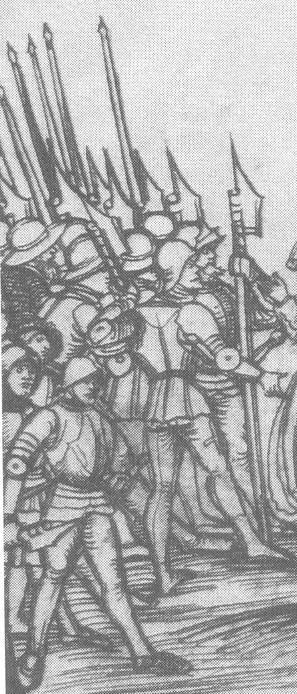
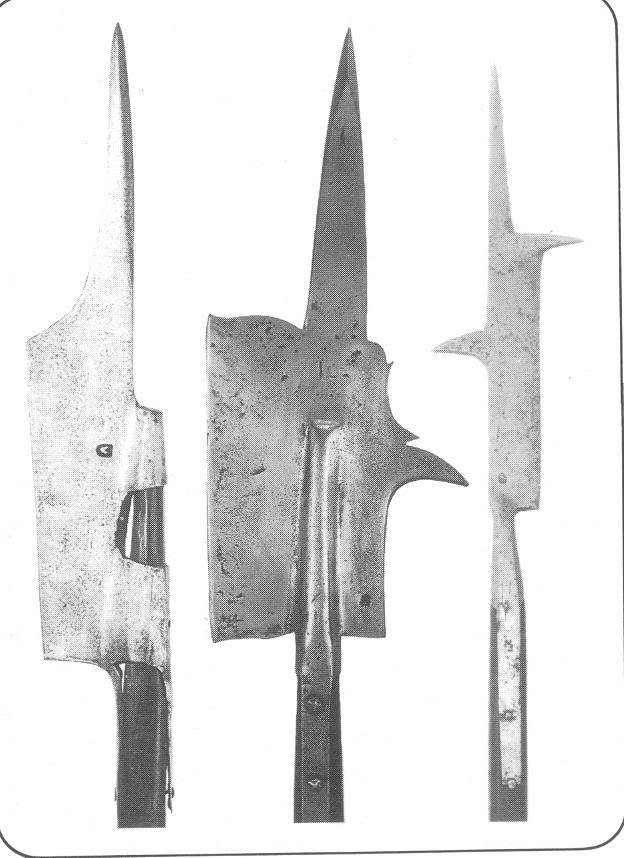
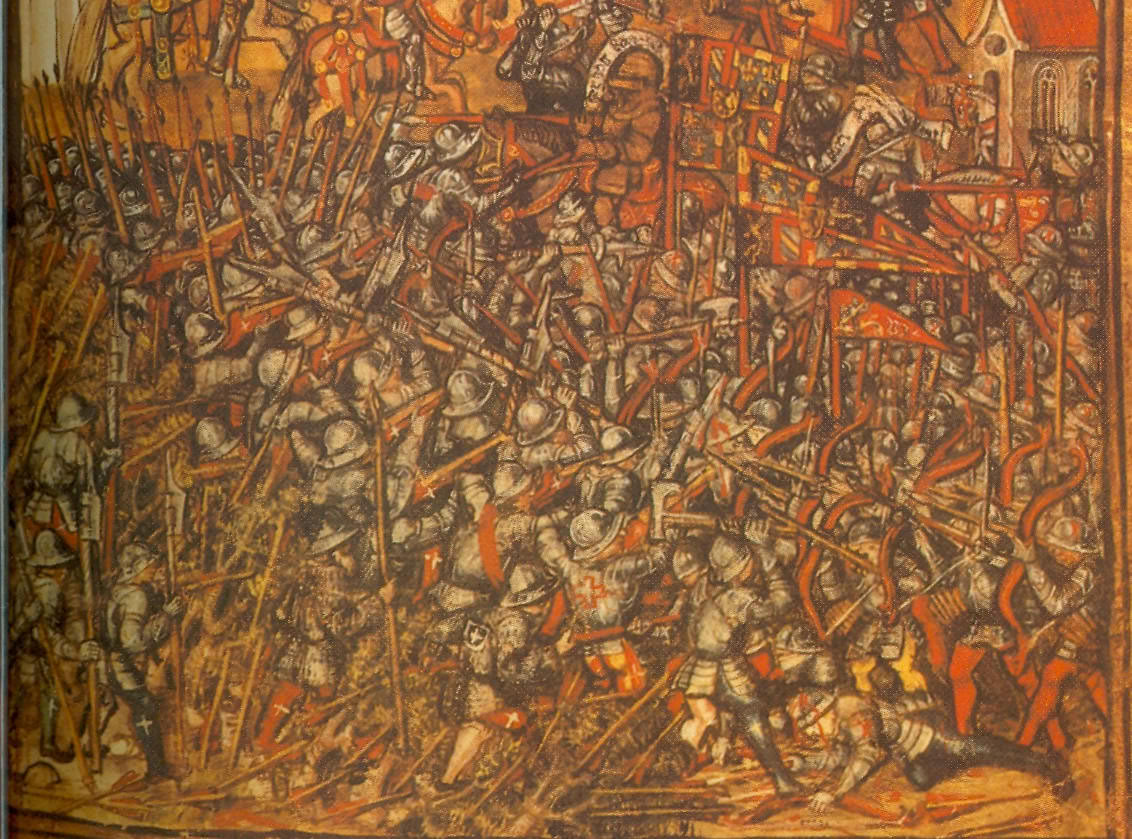
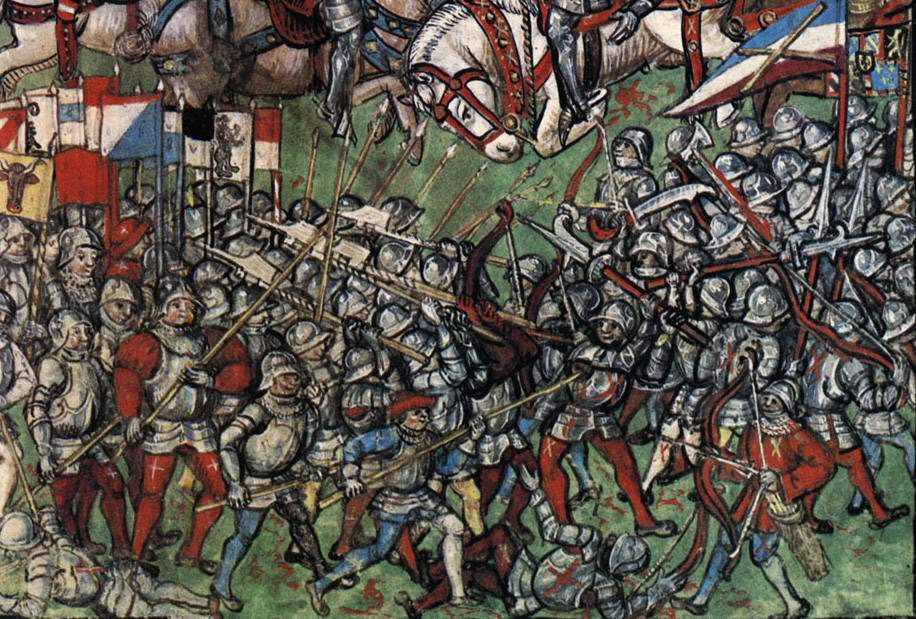
Compare with for example this image of a 15th Century pollaxes
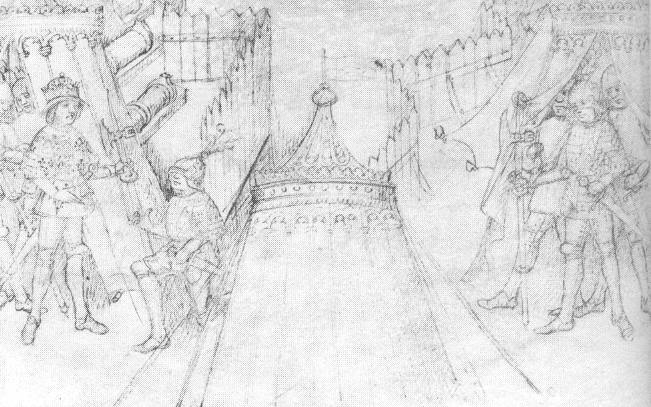
16th Century halberds
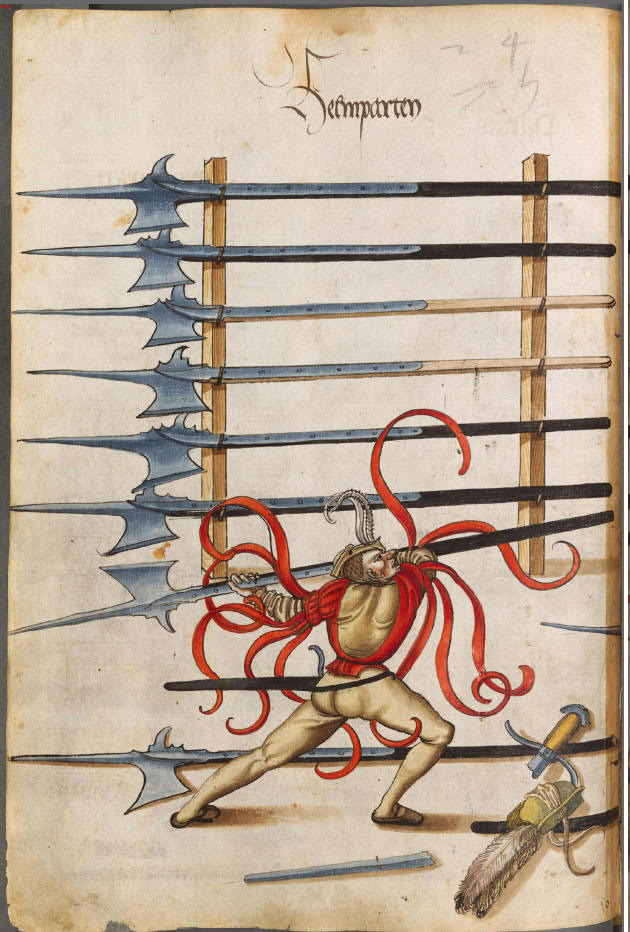
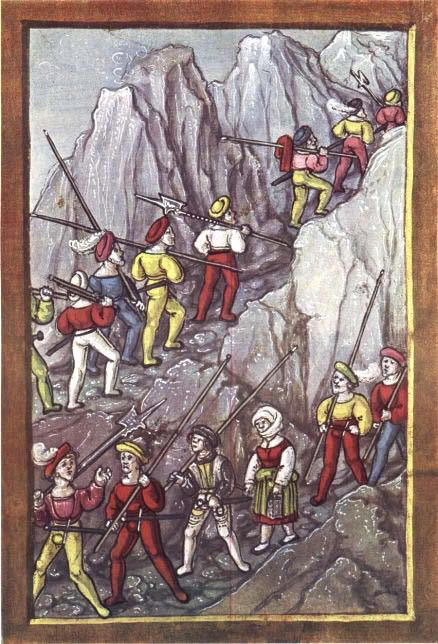
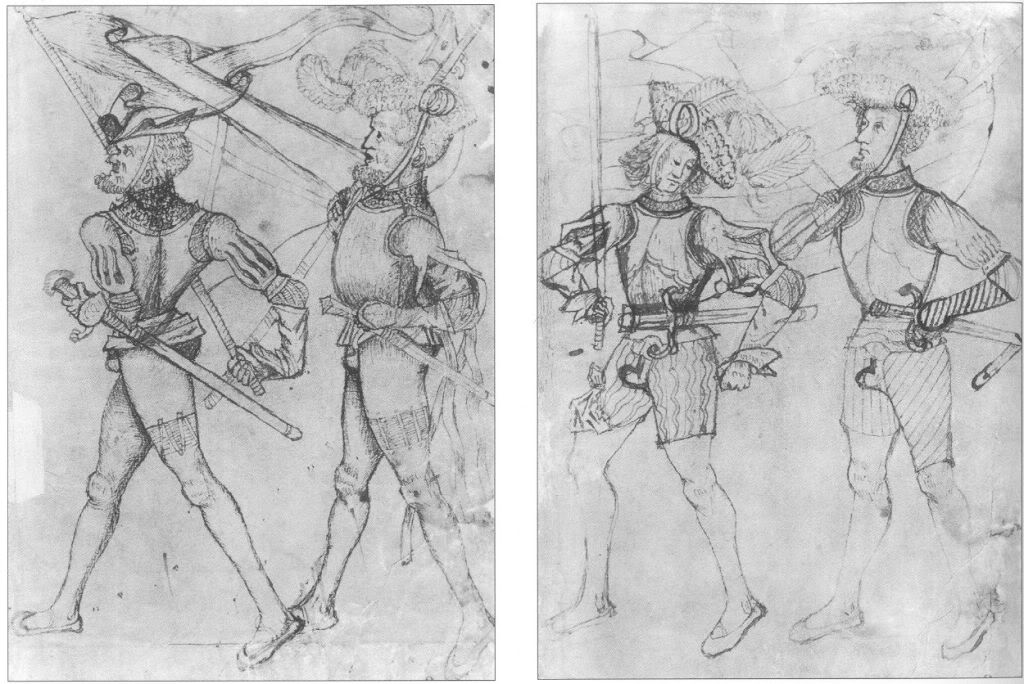

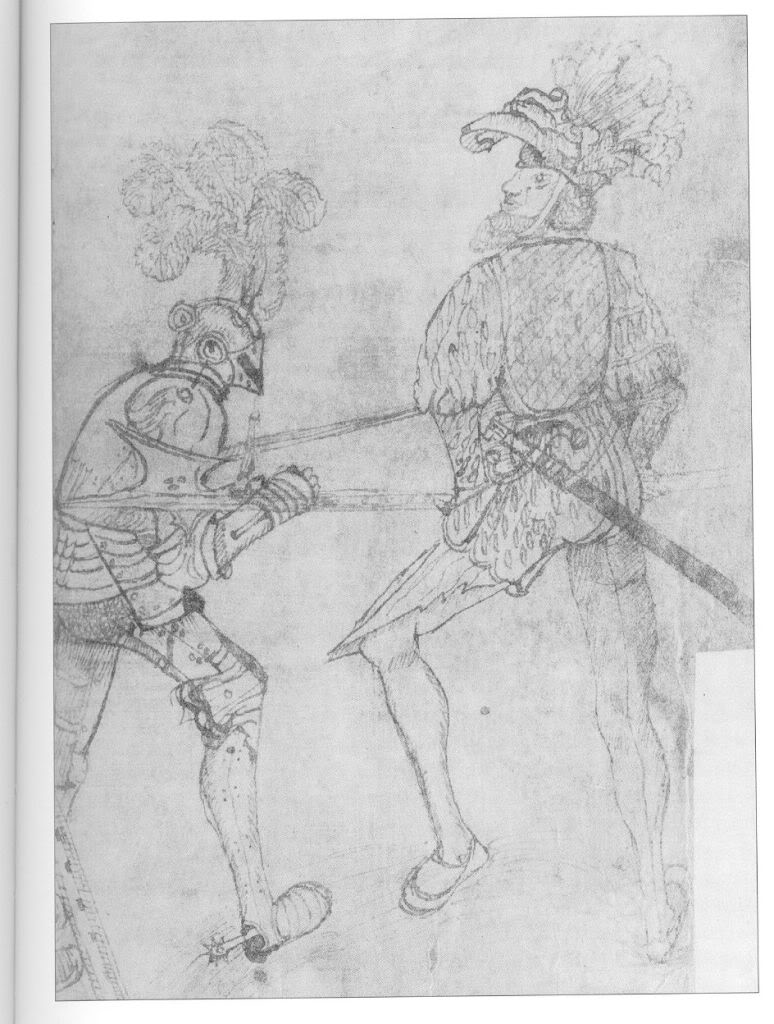

Notice that there is both a halberd and pollaxe in this image
|
|
  |
 |
|
Joe Fults
|
 Posted: Thu 11 Mar, 2010 6:15 pm Post subject: Posted: Thu 11 Mar, 2010 6:15 pm Post subject: |
 |
|
Not that it contributes much to this discussion but I'd just like to note that both weapons are quite a bit of fun to play with. If you can pull it off I highly recommend one of each in your collection. 
"The goal shouldn’t be to avoid being evil; it should be to actively do good." - Danah Boyd
|
|
  |
 |
Nathan M Wuorio

|
 Posted: Thu 11 Mar, 2010 8:28 pm Post subject: Posted: Thu 11 Mar, 2010 8:28 pm Post subject: |
 |
|
Excellent discussion! I've really enjoyed reading all of your comments.
Joe - I'm halfway there, I just got my GDFB halberd mounted on a nice haft, the pollaxe is next! I started a collection of polearms just a couple of months ago, right after I received a spearhead by Windlass for Christmas.
Nathan.
|
|
  |
 |
|
Gregg Sobocinski
|
 Posted: Fri 12 Mar, 2010 9:00 am Post subject: Posted: Fri 12 Mar, 2010 9:00 am Post subject: |
 |
|
If my memory is correct, John Waldman (Hafted Weapons in Medieval and Renaissance Europe, 2005) defined the two categories by their construction technique.
According to Waldman, the Halberd is constructed with a blade folding technique to create the socket, and I seem to remember it is formed as one piece, spikes and all. His description reminded me of an evolved axe construction technique.
The polaxe is constructed using a weapon head, which is held on with a metal strap/langet, which wraps over the top of the weapon head and over both sides of the shaft. This strap would either fit over a square spike (passing through a hole), or a short blade could be attached to the strap at the top of the haft. Two straps could be used instead of passing the strap over the top of the weapon head.
He spends a great deal of his book writing about the halberd, in case you’re interested.
|
|
  |
 |
|
Hugh Knight
|
 Posted: Fri 12 Mar, 2010 11:31 am Post subject: Posted: Fri 12 Mar, 2010 11:31 am Post subject: |
 |
|
| Gregg Sobocinski wrote: | If my memory is correct, John Waldman (Hafted Weapons in Medieval and Renaissance Europe, 2005) defined the two categories by their construction technique.
According to Waldman, the Halberd is constructed with a blade folding technique to create the socket, and I seem to remember it is formed as one piece, spikes and all. His description reminded me of an evolved axe construction technique.
The polaxe is constructed using a weapon head, which is held on with a metal strap/langet, which wraps over the top of the weapon head and over both sides of the shaft. This strap would either fit over a square spike (passing through a hole), or a short blade could be attached to the strap at the top of the haft. Two straps could be used instead of passing the strap over the top of the weapon head.
He spends a great deal of his book writing about the halberd, in case you’re interested. |
We've already discussed that source, I think. Unfortunately, that definition doesn't support the medieval terminology.
Regards,
Hugh
www.schlachtschule.org
|
|
    |
 |
Victor R.

|
 Posted: Mon 04 Nov, 2024 1:37 pm Post subject: Posted: Mon 04 Nov, 2024 1:37 pm Post subject: |
 |
|
A bit of necromancy.
An individual posted a picture from an Osprey book seeking to figure out how to classify a certain polearm in hopes of finding more about it. A reverse image search using just that item brought me to this thread, as it also has the original picture showing it and two items clearly qualifying as "halberds".
Thought it was in Waldman, but is not, and I can't find any other illustration of it, though it looked familiar and I thought I had seen it before. I concluded it would likely be classified as a form of "bill", and my search for the object this morning turned up a copy of the same picture with drawings and annotations that called it a bill as well,
With all of the expertise running around here, what say you? I've included an extract of the item in question, as well as the "enhanced" version of the picture/illustration.
 Attachment: 17.79 KB Attachment: 17.79 KB

"Bill" or otherwise?
 Attachment: 82.15 KB Attachment: 82.15 KB
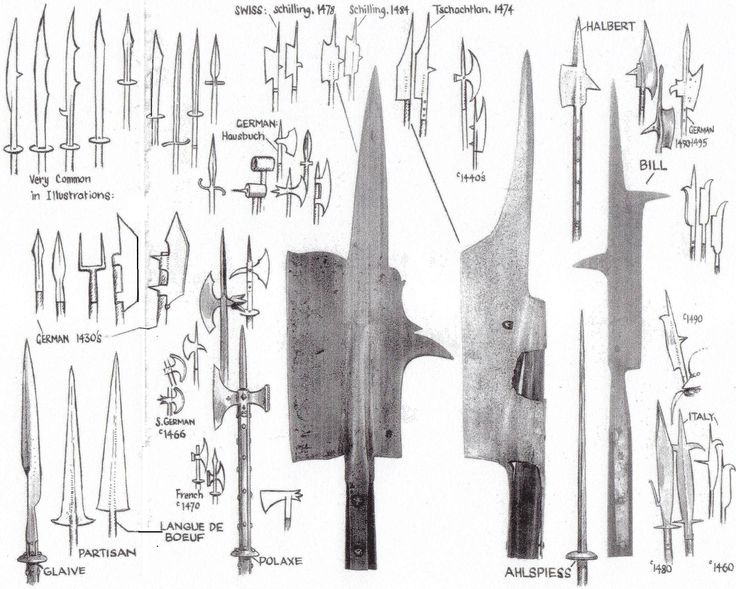
A bit of an agglomeration where someone has labeled it a "bill".
|
|
  |
 |
|
Ryan S.
|
 Posted: Fri 08 Nov, 2024 11:33 am Post subject: Posted: Fri 08 Nov, 2024 11:33 am Post subject: |
 |
|
|
I think that polearms are very hard to classify, and there is a tendency to treat different terminology as representing a typology. I would probably call that a bill, although it might be called a glaive with spikes.
|
|
  |
 |
Victor R.

|
 Posted: Fri 08 Nov, 2024 1:09 pm Post subject: Posted: Fri 08 Nov, 2024 1:09 pm Post subject: |
 |
|
| Ryan S. wrote: | | I think that polearms are very hard to classify, and there is a tendency to treat different terminology as representing a typology. I would probably call that a bill, although it might be called a glaive with spikes. |
I'd never consider it a glaive: no belly to the cutting edge, and the spike on the cutting edge side is something that disqualifies it entirely in my mind. You see examples with a guard spiked on either side, but any examples with some type of spike or other protrusion from the blade shows such protrusions coming from the spine of the blade, not the other side.
|
|
  |
 |
|
Anthony Clipsom
Location: YORKSHIRE, UK Joined: 27 Jul 2009
Posts: 347
|
 Posted: Sat 09 Nov, 2024 10:49 am Post subject: Posted: Sat 09 Nov, 2024 10:49 am Post subject: |
 |
|
Some might call that a roncone. But then some would call a roncone an Italian bill 
I think we can attempt to be more precise about typology than the people who actually used the things were.
Anthony Clipsom
|
|
  |
 |
Victor R.

|
 Posted: Sat 09 Nov, 2024 4:19 pm Post subject: Posted: Sat 09 Nov, 2024 4:19 pm Post subject: |
 |
|
| Anthony Clipsom wrote: | Some might call that a roncone. But then some would call a roncone an Italian bill 
I think we can attempt to be more precise about typology than the people who actually used the things were. |
Based on the examples in Waldman and things I've seen in other places, the roncone/Italian bill/scorpion all seem to be variations with a common ancestry, probably shared with the earliest halberds - a blade with a spike, and then a beak protruding to catch a horseman and pull him down. Probably an orchard tool or other farm implement, from which so many pole weapons seem to have been derived.
And I'm sure we're all much more "precise" (or anal) - I doubt typologies existed in the Middle Ages and Renaissance, at least in the ways we do it.
|
|
  |
 |
|
|
You cannot post new topics in this forum
You cannot reply to topics in this forum
You cannot edit your posts in this forum
You cannot delete your posts in this forum
You cannot vote in polls in this forum
You cannot attach files in this forum
You can download files in this forum
|
All contents © Copyright 2003-2025 myArmoury.com — All rights reserved
Discussion forums powered by phpBB © The phpBB Group
Switch to the Basic Low-bandwidth Version of the forum
|

